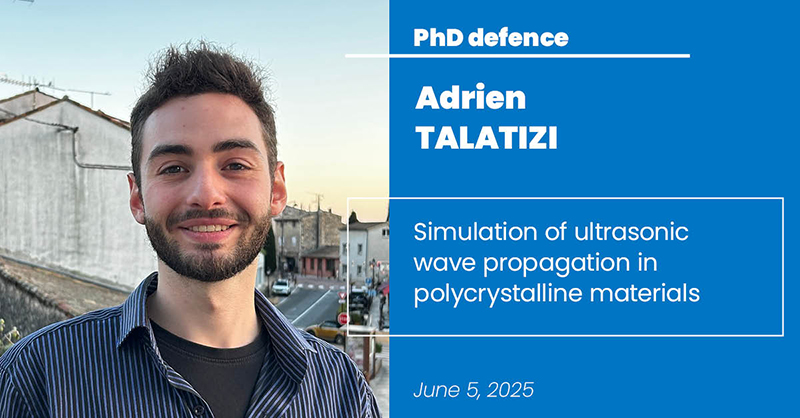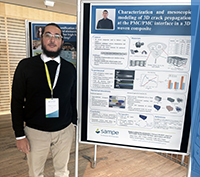PhD defence of Adrien Talatizi

Simulation of ultrasonic wave propagation in polycrystalline materials
Adrien Talatizi conducted his PhD work in the MSR team under the supervision of Marc Bernacki in the framework of a research project with. He will defend his PhD in Computational Mathematics, High Performance Computing and Data, on June 5th, 2025 in front of the following jury:
Mme Bing TIE, CentraleSupelec Paris-Saclay, Rapporteure
Julien BRUCHON, École Nationale Supérieure des Mines de Saint-Étienne Centre Sciences des Matériaux et des Structures, Rapporteur
Stéphane LANTERI, Inria Sophia-Antipolis, Examinateur
Frédéric PRIMA, Chimie Paris PSL, Examinateur
Thomas TOULORGE, Cenaero, Examinateur
Marc BERNACKI, Mines Paris PSL, Examinateur
Mme Cécile BRüTT, Safran Tech, Invitée
Michel SABY, Aubert & Duval, Invité
Abstract:
The metallurgical industry plays a crucial role in the industrial sector, particularly in high-stakes fields such as nuclear, aerospace and defense engineering. Ultrasonic Testing (UT) is widely employed to ensure the quality of forged metallic components. However, practitioners face significant challenges, notably due to signal pollution caused by spurious reflections of ultrasonic waves from the polycrystalline microstructure of metals. In this context, a high-fidelity numerical simulation tool would enable a more accurate characterization of ultrasonic waves behavior as they propagate through polycrystalline materials, allowing a better understanding of the received signals. Furthermore, advanced techniques such as laser-based Ultrasonic Testing for monitoring thermomechanical processes are currently under development. The coupling of numerical simulation tools for microstructure evolution during material forming with those dedicated to ultrasonic wave propagation offers a promising approach. This PhD work was dedicated to the development of a high-fidelity simulation tool, building upon the state of the art and following three main steps:
- defining a model to describe ultrasonic wave propagation in polycrystals,
- developing an appropriate numerical scheme to solve this model,
- validating the resulting model.
To achieve this, the developed model is based on the first-order velocity-stress ElastoDynamics wave propagation equations. This model is solved using a Discontinuous Galerkin spatial scheme, combined with explicit time integrators such as Leap-Frog and Runge-Kutta methods. Finally, the features and performance of the resulting simulation environment are assessed through academic test cases before being applied to numerical polycrystalline microstructures, closely resembling configurations encountered in experimental Ultrasonic Testing.
Keywords: numerical simulation, digital shadow, elastic wave propagation, polycrystals, finite elements, discontinuous galerkin








